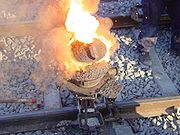
Aluminothermic reaction
Encyclopedia
Aluminothermic reactions are exothermic
chemical reactions using aluminium
as the reducing agent
at high temperature. The most prominent example is the thermite
reaction between aluminium and iron oxides:
n scientist Nikolay Beketov, who proved that aluminum restored metals from their oxide
s under high temperatures. The reaction was first used for the carbon-free reduction of metal oxides. The reaction is highly exothermic, but it has a high activation energy since strong interatomic bonds in the solids must be broken first. The oxide was heated with aluminium in a crucible in a furnace. The runaway reaction made it possible to produce only small quantities of material. Hans Goldschmidt
improved the aluminothermic process between 1893 and 1898, by igniting the mixture of fine metal oxide and aluminium powder by a starter reaction without heating the mixture externally. The process was patented in 1898 and used extensively in the later years for rail track welding.
 A common use of this reaction is the welding of rail tracks
A common use of this reaction is the welding of rail tracks
on-site, useful for complex installations or local repairs that cannot be done using continuously welded rail.
Another common use is the welding of copper cables (wire) for use in direct burial (grounding/earthing) applications. It is still the only type of electrical connection recognized by the IEEE (IEEE, Std 80-2001) as continuous un-spliced cable.
The aluminothermic reaction is also used for the production of most of the ferroalloys, for example ferroniobium
from niobium pentoxide
. Other metals can be produced in the same way.
Exothermic reaction
An exothermic reaction is a chemical reaction that releases energy in the form of light or heat. It is the opposite of an endothermic reaction. Expressed in a chemical equation:-Overview:...
chemical reactions using aluminium
Aluminium
Aluminium or aluminum is a silvery white member of the boron group of chemical elements. It has the symbol Al, and its atomic number is 13. It is not soluble in water under normal circumstances....
as the reducing agent
Redox
Redox reactions describe all chemical reactions in which atoms have their oxidation state changed....
at high temperature. The most prominent example is the thermite
Thermite
Thermite is a pyrotechnic composition of a metal powder and a metal oxide that produces an exothermic oxidation-reduction reaction known as a thermite reaction. If aluminium is the reducing agent it is called an aluminothermic reaction...
reaction between aluminium and iron oxides:
- Fe2O3 + 2 Al → 2 Fe + Al2O3
History
Aluminothermy started from the experiments of RussiaRussia
Russia or , officially known as both Russia and the Russian Federation , is a country in northern Eurasia. It is a federal semi-presidential republic, comprising 83 federal subjects...
n scientist Nikolay Beketov, who proved that aluminum restored metals from their oxide
Oxide
An oxide is a chemical compound that contains at least one oxygen atom in its chemical formula. Metal oxides typically contain an anion of oxygen in the oxidation state of −2....
s under high temperatures. The reaction was first used for the carbon-free reduction of metal oxides. The reaction is highly exothermic, but it has a high activation energy since strong interatomic bonds in the solids must be broken first. The oxide was heated with aluminium in a crucible in a furnace. The runaway reaction made it possible to produce only small quantities of material. Hans Goldschmidt
Hans Goldschmidt
Johannes Wilhelm "Hans" Goldschmidt was a German chemist.Born in Berlin, he was a student of Robert Bunsen. His father, Theodor Goldschmidt, was the founder of the chemical company Chemische Fabrik Th...
improved the aluminothermic process between 1893 and 1898, by igniting the mixture of fine metal oxide and aluminium powder by a starter reaction without heating the mixture externally. The process was patented in 1898 and used extensively in the later years for rail track welding.
Applications

Rail tracks
The track on a railway or railroad, also known as the permanent way, is the structure consisting of the rails, fasteners, sleepers and ballast , plus the underlying subgrade...
on-site, useful for complex installations or local repairs that cannot be done using continuously welded rail.
Another common use is the welding of copper cables (wire) for use in direct burial (grounding/earthing) applications. It is still the only type of electrical connection recognized by the IEEE (IEEE, Std 80-2001) as continuous un-spliced cable.
The aluminothermic reaction is also used for the production of most of the ferroalloys, for example ferroniobium
Ferroniobium
Ferroniobium is an important iron niobium alloy, with a niobium content of 60-70%. It is the main source for niobium alloying of HSLA steel and covers more than 80% of the world wide niobium production. The niobium is mined from pyrochlore deposits and is subsequently transformed into the niobium...
from niobium pentoxide
Niobium pentoxide
Niobium pentoxide is the inorganic compound with the formula Nb2O5. It is a colourless insoluble solid that is fairly unreactive. It is the main precursor to all materials made of niobium, the dominant application being alloys, but other specialized applications include capacitors, lithium niobate,...
. Other metals can be produced in the same way.

